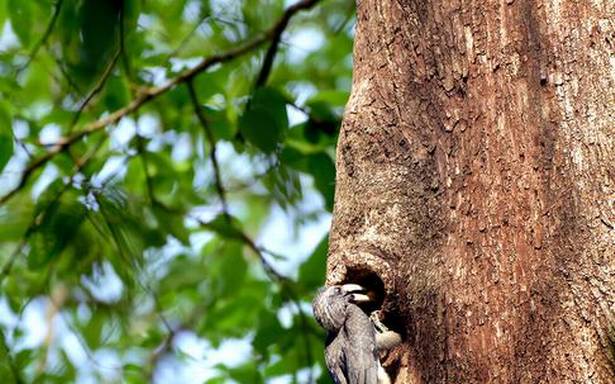Research highlights the perils posed by the loss of large cavity-bearing trees
Loss of large old trees, with cavities that harbour a wide variety of species, has become a concern in many ecosystems.
According to research conducted by a team of scientists led by Peroth Balakrishnan, scientist and head, Department of Wildlife Biology, Kerala Forest Research Institute, 517 species, which is about 18.4% of terrestrial vertebrate species of India, use tree cavities.
Their research on ‘Patterns of tree cavity occurrence and use by vertebrates in tropical forests of the Western Ghats’ stresses that tree cavities play a key role in the functioning of forest ecosystems.
“Trees with cavities are considered an important parameter in wildlife conservation and forest management. Their loss is a recognised concern in ecosystems worldwide,” says Dr. Balakrishnan.
The residents
Species that use tree cavities, like bats, hornbills, woodpeckers, and civets, are well-known service providers to the ecosystem and play crucial roles in pollination, seed dispersal, and pest control. “About 9% of tree-cavity users are red listed and deserve special conservation because of habitat loss. Therefore, cavity-bearing tree species have become a key target for conservation management.”
Rare, threatened
Research shows that about 50% of the trees use by the south Indian hornbills belong to rare, endangered, or threatened categories.
Among the 517 species that use tree cavities, 43.9% are birds, followed by reptiles (30.8%), mammals (17.6%) and amphibians (7.7%). Most of them are rare, elusive, and nocturnal species. While 51.4% of them use cavities for breeding, 23.8% roost in the dark holes. Another 9.3% use them as den or day rest sites, and 0.8% species use them to hibernate.
Of the tree-cavity users, 54 species (10.4%) are primary users (woodpeckers, barbets, trogons and nuthatches) and 463 (89.6%) were secondary users (hornbills, owls, parrots, tits, starlings, flycatchers, bats, tree squirrels, tree mice, civets and martens) which depend on primary excavators.
The research has been funded by the Ministry of Environment, Forest and Climate Change. The review paper was published in Current Science (August 25, 2021) titled “Use of tree cavities by Indian vertebrates: status of research, knowledge gaps and future conservation perspectives” authored by Peroth Balakrishnan, Bharati Patel and Sreejith Sivaraman. Bharati Patel and Sreejith Sivaraman are PhD students at the KFRI.
Source: Read Full Article

